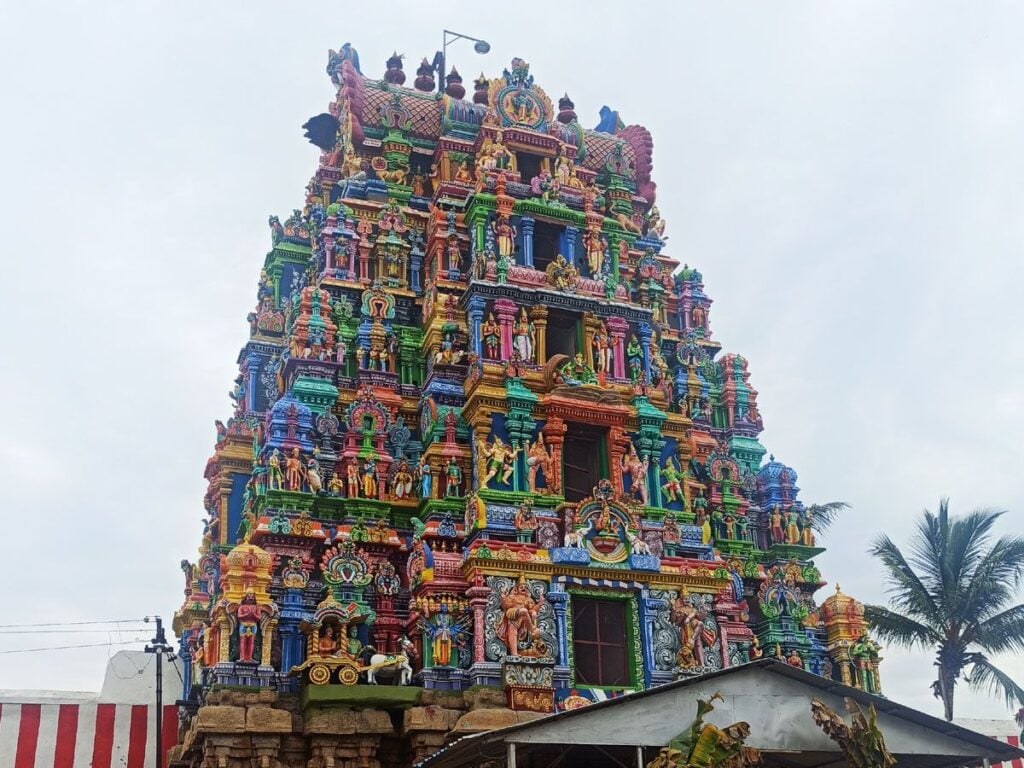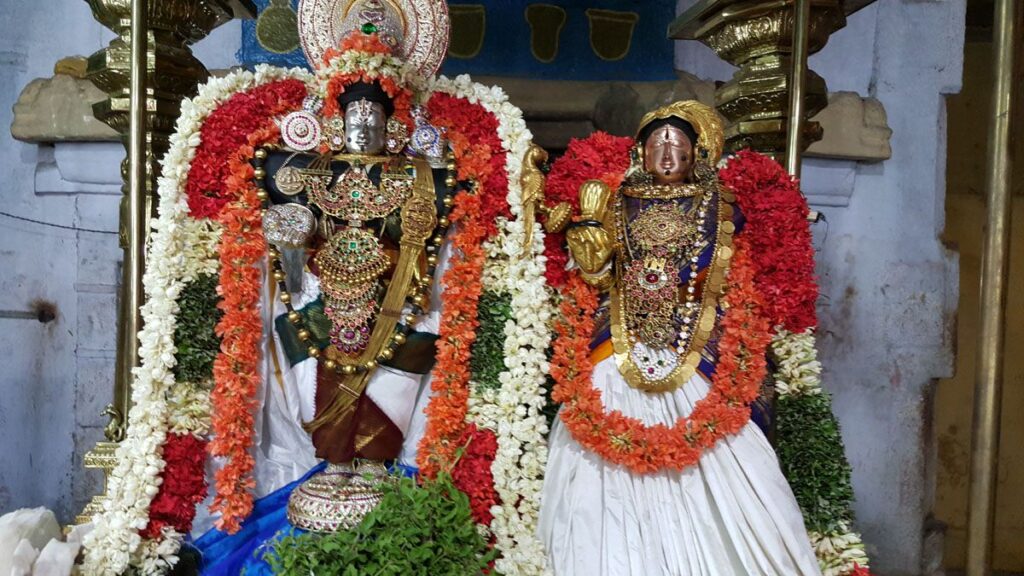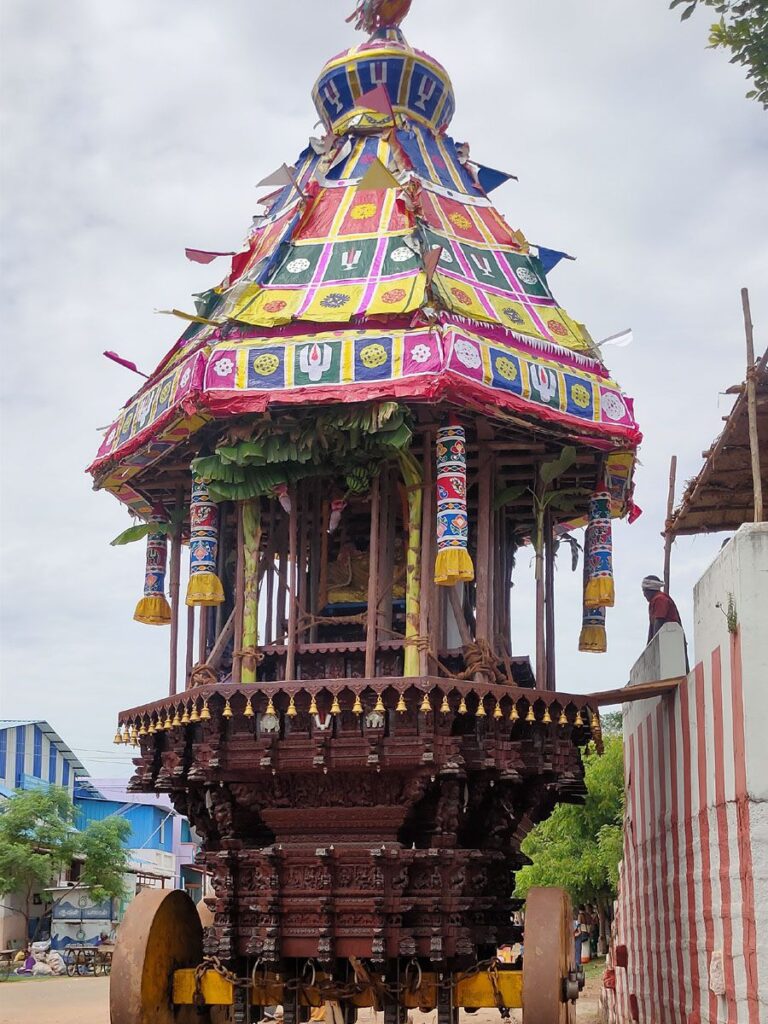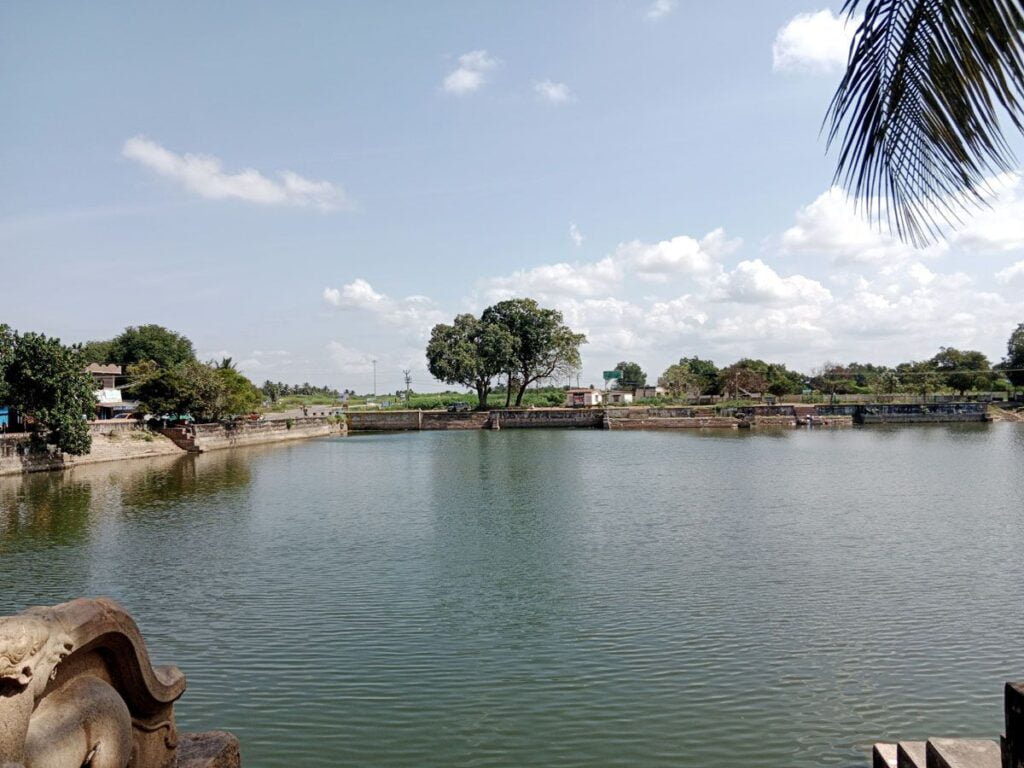Thirukoshtiyur Temple of Sowmya Narayana Perumal
The Thirukoshtiyur Temple, also known as the Sowmya Narayana Perumal Temple, is an ancient Hindu temple dedicated to the god Vishnu. It is located in Thirukoshtiyur, a village in the South Indian state of Tamil Nadu.

Contents
- 1 History of Thirukoshtiyur Temple of Sowmya Narayana Perumal:
- 2 Legend of Thirukoshtiyur Temple of Sowmya Narayana Perumal:
- 3 Significance of Thirukoshtiyur Temple of Sowmya Narayana Perumal:
- 4 Myths of Thirukoshtiyur Temple of Sowmya Narayana Perumal:
- 5 Architecture of Thirukoshtiyur Temple of Sowmya Narayana Perumal:
- 6 Thirukoshtiyur Temple Timing and Rituals:
- 7 Places to visit near Thirukoshtiyur Temple:
- 8 FAQ:
- 9 How to reach Thirukoshtiyur Temple:
- 10 Google Maps:
History of Thirukoshtiyur Temple of Sowmya Narayana Perumal:
- The name Thirukoshtiyur translates to “sacred group town”. Legends say it was the meeting place for Brahma, Shiva, all the devas (celestial beings), and the sapta rishis (seven sages) to discuss vanquishing the demon Asura Eraniyan.
- Another legend from the Periyalvar Tirumoli text suggests Thirukoshtiyur as the birthplace of Lord Krishna.
Significance in Vaishnavism:
- Thirukoshtiyur Temple is one of the 108 Divya Desams, revered holy shrines for Vaishnavites, followers of Vishnu.
- The temple is glorified in the Nalayira Divya Prabandham, a collection of hymns by Alvar saint poets from 6th-9th centuries CE.
- The temple enshrines Lord Vishnu as Sowmya Narayana Perumal and his consort Lakshmi as Thirumamagal.
Ramanuja’s Connection:
- Thirukoshtiyur is known as the birthplace of Ramanuja’s teacher, Thirukoshtiyur Nambigal.
- Nambigal taught Ramanuja a sacred verse but instructed him to keep it secret. Ramanuja, believing it should be shared with everyone, climbed the temple and revealed the verse, earning him the title “Emperumanar” (meaning superior) from Nambigal.
Read More>> Thirumalai Kumaraswamy Temple

Legend of Thirukoshtiyur Temple of Sowmya Narayana Perumal:
- Meeting of the Divine and the Fight Against Evil: According to the legend, during the Satya Yuga (age of truth), the demon Hiranyakashipu wreaked havoc on the rishis (sages), devas (celestial beings), and humans. Seeking a solution, the devas and rishis approached Brahma and Shiva. The divine decided to meet and strategize, choosing Thirukoshtiyur (meaning “sacred group town”) as their meeting place. Here, they likely discussed how to defeat Hiranyakashipu, who would ultimately be slain by Vishnu’s Narasimha avatar.
- Ramanuja and the Ashtakshara Mantra: This legend centers around Ramanuja, a key figure in Vaishnavism. Ramanuja’s teacher, Thirukoshtiyur Nambigal, instructed him in the sacred Ashtakshara mantra (“Om Namo Narayana”). However, Nambigal forbade Ramanuja from revealing it to anyone else, warning of dire consequences. Believing everyone deserved the mantra’s benefits, Ramanuja climbed the temple and revealed it to the public. Though defying his teacher, Ramanuja’s act of compassion impressed Nambigal, who bestowed upon him the title “Emperumanar” (meaning “superior”).
Read More>> Magnificent Ramanathaswamy Temple: A Marvel of Architecture

Significance of Thirukoshtiyur Temple of Sowmya Narayana Perumal:
Divya Desam:
- The temple is one of the 108 Divya Desams, which are revered as holy abodes of Vishnu by Vaishnavites. These sites were glorified by the hymns of Alvar saints between the 6th and 9th centuries CE.
Lord Vishnu and Ramanuja:
- Thirukoshtiyur Temple enshrines Lord Vishnu as Sowmya Narayana Perumal alongside his consort, Goddess Lakshmi as Thirumamagal.
- Ramanuja, a prominent Vaishnava philosopher, is believed to have revealed the sacred “Ashtakshara” mantra (“Om Namo Narayana”) to the public here, defying his teacher’s instructions. This act aimed to make salvation accessible to all, earning him the title “Emperumanar” (superior).
Other Legends and Historical Significance:
- The name “Thirukoshtiyur” itself translates to “sacred group town”. Legend says it derives from the gathering of deities here, including the divine trinity (Brahma, Vishnu, Shiva) and celestials (Devas), to strategize against the demon king, Hiranyakashipu.
- Some believe this temple is the birthplace of Krishna, as envisioned by the Alvar saint Periyalvar.
- The temple’s architecture reflects the Dravidian style and is considered an ancient site.
Read More>> 6th CE Sarangapani Temple Kumbakonam

Myths of Thirukoshtiyur Temple of Sowmya Narayana Perumal:
- Meeting of the Devas and Rishis: In the Satya Yuga (golden age), the demon king Hiranyakashipu wreaked havoc on the world. Devas (celestial beings), rishis (sages) and humans all suffered under his tyranny. Seeking a solution, they decided to meet and discuss how to defeat him. Thirukoshtiyur is believed to be the chosen place for this historic gathering. This is why the name itself combines “Tiru” (sacred), “kōṣṭi” (group), and “ūr” (town), signifying the coming together of a multitude.
- Ramanuja and the Ashtakshara Mantra: Ramanuja, a famous Vaishnava saint, had Thirukoshtiyur Nambigal as his teacher. Nambigal taught Ramanuja the sacred Ashtakshara Mantra, “Om Namo Narayana,” but forbade him from revealing it to anyone else, warning of dire consequences. Ramanuja, however, believed everyone deserved the chance to attain salvation through this mantra. In a selfless act, he climbed the temple’s highest point and recited the mantra for the entire village to hear, defying his teacher’s orders. Nambigal, recognizing the purity of Ramanuja’s intentions, was deeply moved. Instead of punishment, he bestowed upon Ramanuja the title “Emperumanar” (meaning “superior”).
Read More>> 3 BC Varahaperumal Temple Kumbakonam
Architecture of Thirukoshtiyur Temple of Sowmya Narayana Perumal:
- Granite Compound Wall: The temple complex is enclosed by a massive granite wall, which serves to demarcate the sacred space from the outside world.
- Rajagopuram: The entrance to the temple is marked by a five-tiered Rajagopuram, a towering gateway tower. These gopurams are a characteristic feature of Dravidian temples and are often adorned with intricate sculptures and vibrant colors.
- Vimana: The sanctum sanctorum, the most sacred part of the temple where the main deity resides, is crowned by a vimana. Unlike the Rajagopuram, the vimana is located directly above the sanctum and is typically pyramidal in shape. The Thirukoshtiyur temple has a unique octagonal-shaped vimana called the Ashtanga Vimana, which is taller than the Rajagopuram and is 82 feet tall. The vimana is adorned with stucco images depicting scenes from Hindu mythology.
- Mandapams: Thirukoshtiyur Temple complex also houses several mandapams, which are pillared halls used for various purposes such as congregations, festivals, and weddings.
- Shrines: In addition to the main sanctum dedicated to Vishnu as Sowmya Narayana Perumal, the temple complex houses several other shrines dedicated to various deities, including Shiva, Ganesha, Subrahmanya, and the Alvar saints.
- Temple Tank: A large temple tank is located opposite the main entrance of the temple. These tanks are used for ritual bathing and are considered to be sacred.
Read More>> Enchanting Chidambaram Nataraja Temple: 5 Formless Akasha Lingam

Thirukoshtiyur Temple Timing and Rituals:
- Morning: Most temples perform a puja (worship ceremony) at sunrise, so you can expect the Thirukoshtiyur Temple to be open around this time, which would be roughly between 6:00 AM and 7:00 AM.
- Afternoon: After a midday closure, the temple reopens in the afternoon, typically between 4:00 PM and 5:00 PM for another puja.
- Evening: Many temples have a final puja around sunset, so the temple might close around 7:00 PM or 8:00 PM.
Here are some of the rituals that might be performed at the Thirukoshtiyur Temple:
- Abhisheka: This is a sacred bath for the deity, typically involving pouring milk, curd, honey, panchamrita (a five-ingredient nectar), and other holy substances over the idol.
- Mangala Aarthi: This is an offering of light to the deity using an oil lamp with several wicks.
- Archana: This involves chanting mantras (sacred hymns) while offering flowers, incense, or other items to the deity.
- Deepa Aarthi: This evening puja involves lighting lamps around the temple complex.
Places to visit near Thirukoshtiyur Temple:
- Pillayarpatti Karpaga Vinayagar Temple: Situated approximately 20 kilometers from Thirukoshtiyur, this temple is dedicated to Lord Ganesha and is famous for its rock-cut architecture and the large idol of Lord Ganesha.
- Karaikudi: Known for its rich cultural heritage and unique architecture, Karaikudi is around 40 kilometers away. It’s famous for its Chettinad mansions, antique shopping, and delicious Chettinad cuisine.
- Athangudi: About 35 kilometers from Thirukoshtiyur, Athangudi is renowned for its handmade Athangudi tiles, which are known for their vibrant colors and intricate designs. You can visit tile-making workshops and explore the village.
- Pudukkottai: This historic town, approximately 50 kilometers away, has several attractions including the Pudukkottai Palace, Aranthangi Fort, and the Chettinad House. It’s also known for its rich cultural heritage.
- Karaikudi Antique Market: If you’re interested in antiquities and traditional artifacts, a visit to the antique market in Karaikudi is a must. You can find a wide range of antique items including furniture, brassware, and sculptures.
- Chettinad Palace: Located in Kanadukathan, around 40 kilometers from Thirukoshtiyur, the Chettinad Palace is a grand mansion showcasing the opulent lifestyle of the Chettiar community. It’s known for its intricate architecture and lavish interiors.
- Kundrakudi Murugan Temple: Situated about 30 kilometers from Thirukoshtiyur, this temple dedicated to Lord Murugan is nestled amidst scenic surroundings and is a popular pilgrimage destination.
FAQ:
General
- What is the significance of the Thirukoshtiyur Temple?
The Thirukoshtiyur Temple, also known as the Sowmya Narayana Perumal Temple, is an ancient Hindu temple dedicated to Lord Vishnu. It’s revered for its unique octagonal vimana and its connection to the Vaishnava saint Ramanuja.
- Where is the temple located?
The temple is located in the village of Thirukoshtiyur, in the Kanchipuram district of Tamil Nadu, India.
Architecture
- What is the architectural style of the temple?
Thirukoshtiyur Temple is built in the Dravidian style of architecture, characterized by towering gopurams, pyramidal vimana, and pillared halls (mandapams).
- What’s unique about the temple’s vimana?
The vimana, called the Ashtanga Vimana, is octagonal-shaped, which is quite rare. It’s also taller than the Rajagopuram, standing at 82 feet.
Deities and Shrines
- Who is the main deity of the temple?
Lord Vishnu, worshipped as Sowmya Narayana Perumal.
- Are there other shrines within the temple complex?
Yes, there are shrines dedicated to Shiva, Ganesha, Subrahmanya, and the Alvar saints.
Visiting the Temple
- What are the timings for visiting the temple?
Temple timings can vary depending on the day of the week. It’s best to check with a local source or temple website (if available) for the most up-to-date timings.
- Is there a dress code for visiting the temple?
While there’s no strict dress code, modest clothing that covers shoulders and knees is considered respectful for temple visits in India.
- Does the temple offer any special services for pilgrims?
Some temples offer poojas (prayers) or other services for pilgrims. It’s recommended to inquire with the temple authorities or local priests for details.
Additional Information
- Is there a temple tank associated with the temple?
Yes, Thirukoshtiyur Temple complex has a large temple tank located opposite the main entrance, used for ritual bathing.
- What is the historical significance of the temple?
The temple is associated with the Vaishnava saint Ramanuja. Legend says he sought refuge here.
How to reach Thirukoshtiyur Temple:
- By Road: Thirukoshtiyur is well-connected by road. You can hire a taxi or use private or public buses from nearby towns and cities such as Madurai, Karaikudi, and Sivaganga. The temple is easily accessible via the NH-36 (National Highway 36) and other state highways.
- By Train: The nearest railway station to Thirukoshtiyur is the Sivaganga Railway Station, which is about 25 kilometers away. From the railway station, you can hire a taxi or take a bus to reach the temple.
- By Air: The nearest airport to Thirukoshtiyur is the Madurai Airport, located approximately 70 kilometers away. From Madurai, you can hire a taxi or take a bus to reach Thirukoshtiyur.
